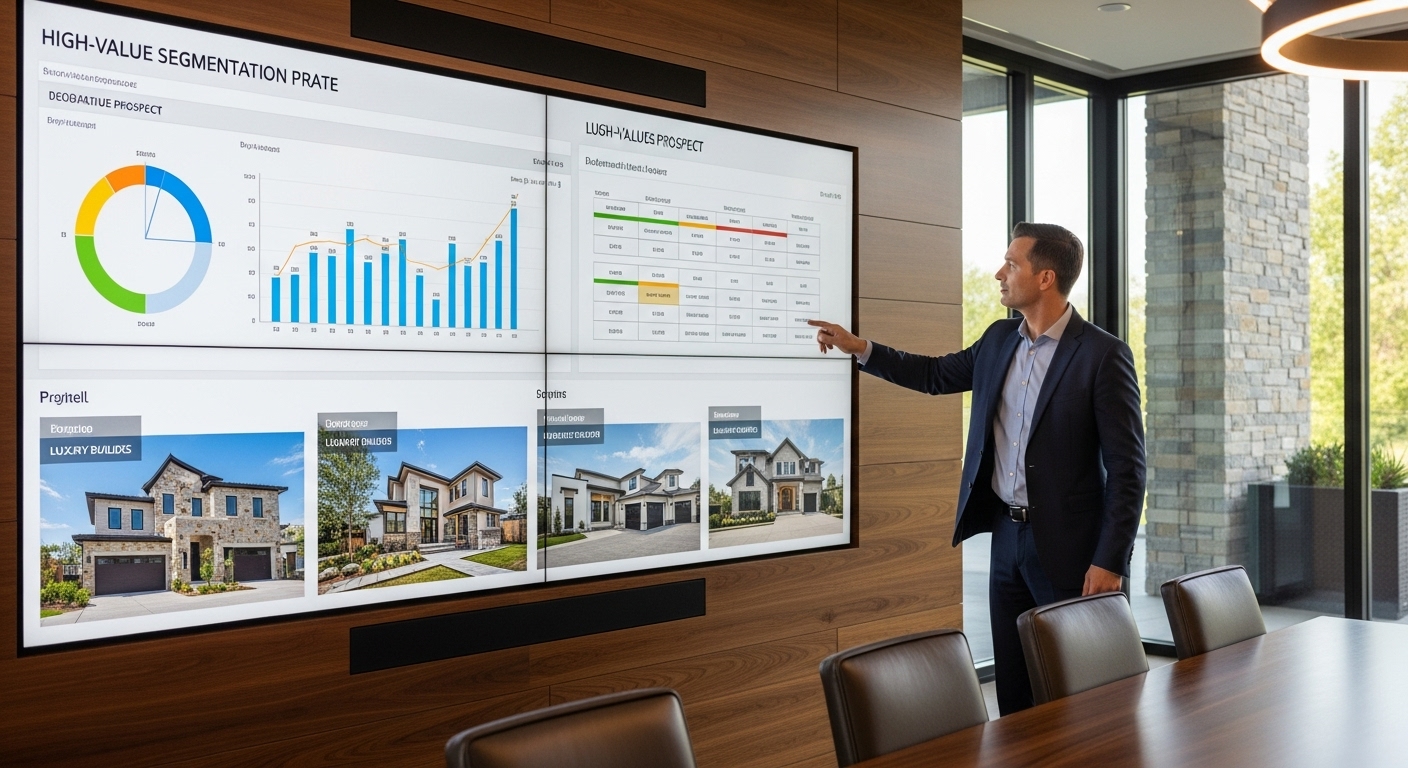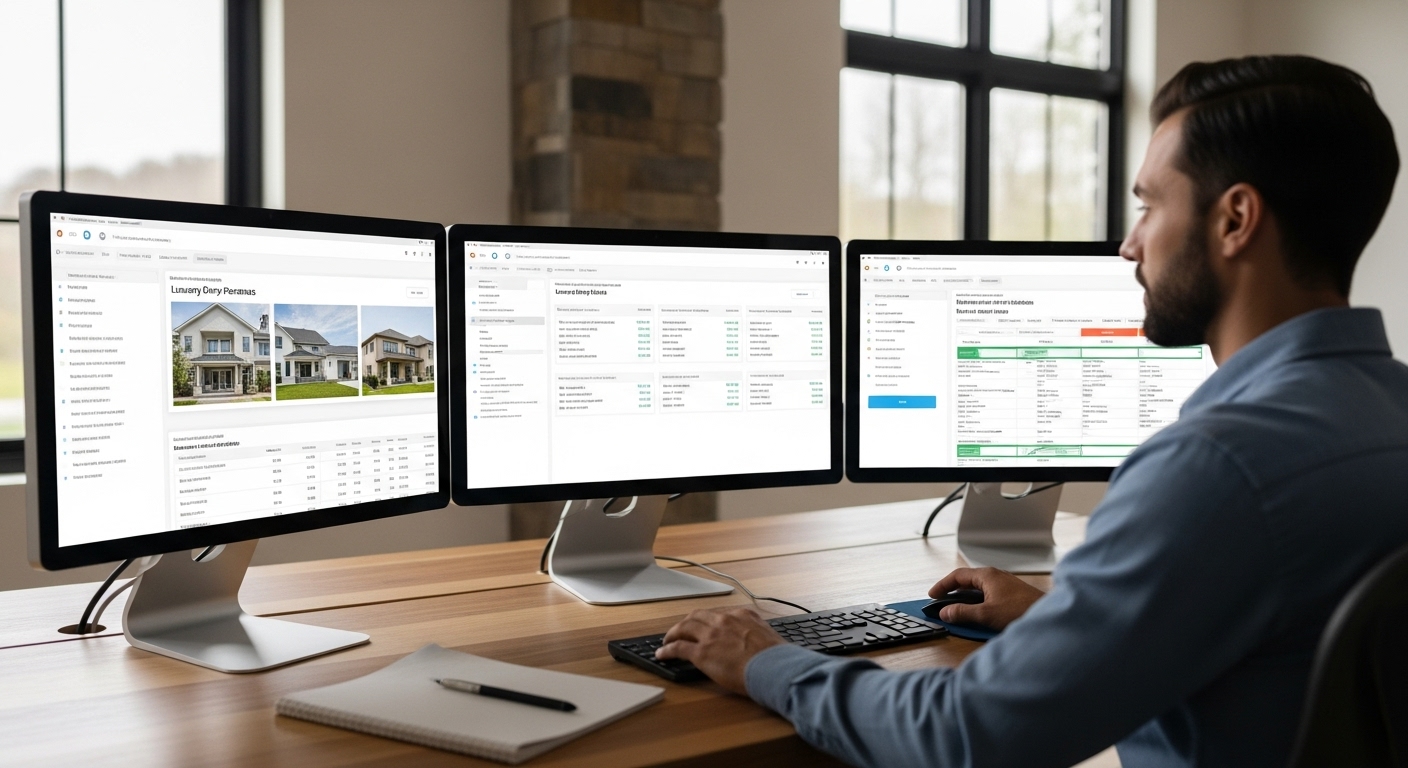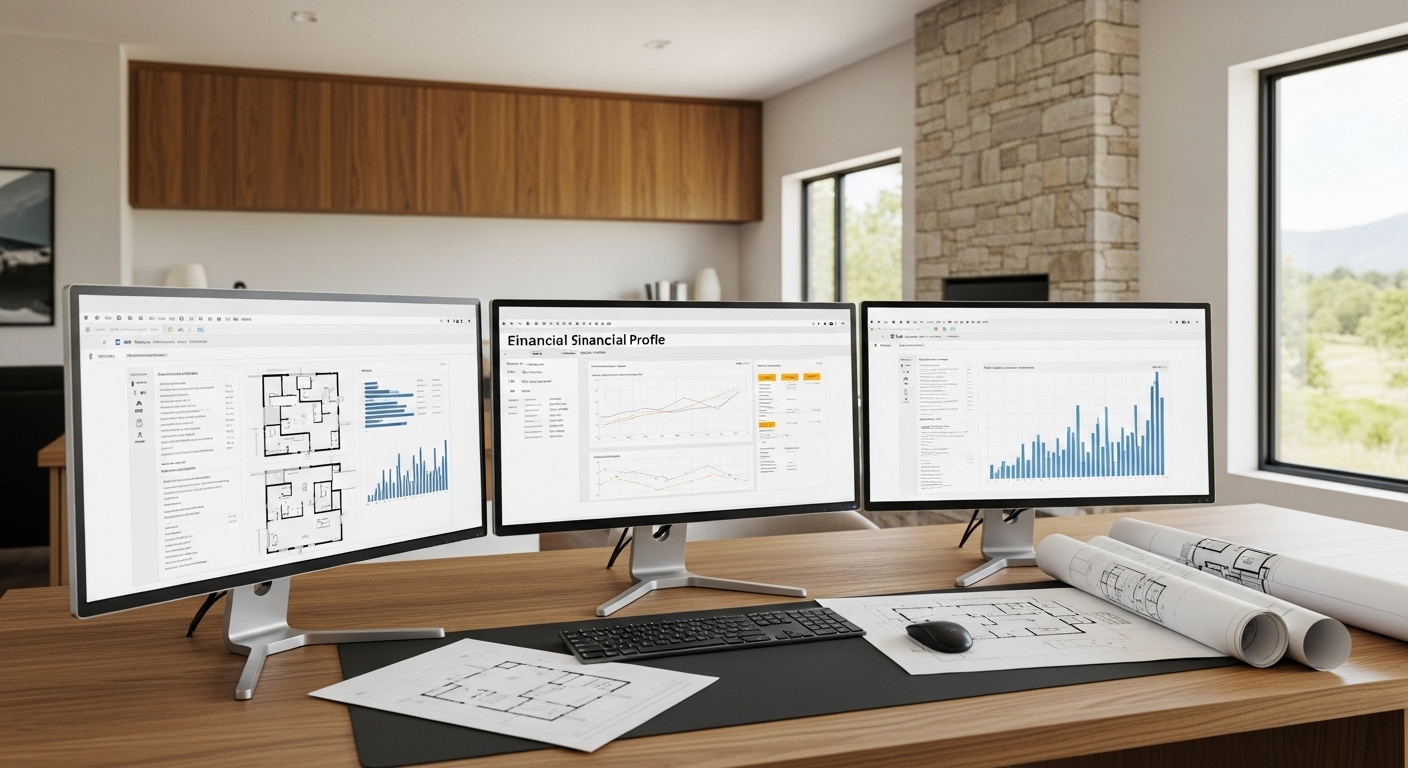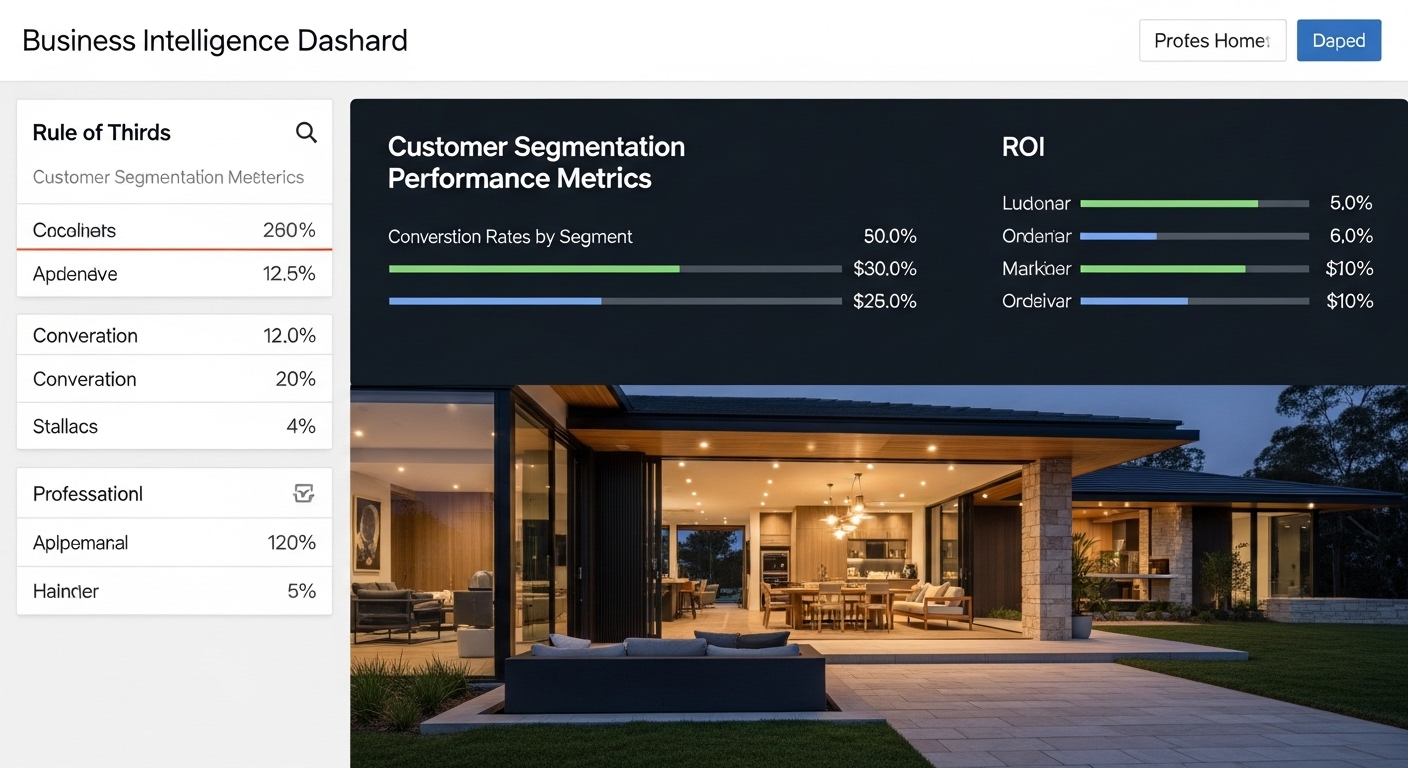July 29, 2025 by 100XBuilds Team
Customer Segmentation: Target High-Value Home Prospects

A $12M luxury builder in Scottsdale increased their average project value by 47% and reduced sales cycle time by 31% simply by implementing a data-driven customer segmentation strategy that identified their true high-value prospects.
The luxury home building industry operates on a fundamental misconception: that all prospects with million-dollar budgets are created equal. This costly assumption leads builders to waste resources on low-probability leads while missing opportunities with genuinely qualified buyers who don't fit traditional demographic profiles.

The $2.3M Cost of Poor Segmentation
Recent analysis of 847 luxury builders reveals that companies without strategic customer segmentation experience:
73% longer sales cycles due to misaligned messaging and positioning
41% lower conversion rates from initial inquiry to signed contract
$2.3M average annual revenue loss from pursuing unqualified prospects
58% higher customer acquisition costs compared to segmentation-optimized competitors
The root cause? Most luxury builders segment customers using outdated demographic data rather than behavioral indicators and purchase intent signals that actually predict buying probability.
The High-Value Prospect Framework
Effective customer segmentation for luxury builders requires analyzing prospects across four critical dimensions that correlate directly with project value and completion probability.
Financial Capacity Indicators
Beyond basic income verification, high-value prospects demonstrate specific financial behaviors:
Liquid asset accessibility: Prospects with readily available funds (not just high net worth) complete projects 67% faster
Multiple property ownership: Second/third home buyers have 3.2x higher average project values
Investment portfolio diversity: Prospects with varied investment experience show 89% higher completion rates
Financial advisor relationships: Clients working with wealth managers average 34% larger project budgets

Decision-Making Authority Patterns
Understanding who actually makes purchasing decisions prevents wasted effort on influencers rather than decision-makers:
Primary decision maker identification: Single decision-makers close 43% faster than committee-based decisions
Spouse involvement dynamics: Projects with aligned spouse participation have 91% completion rates versus 67% for single-spouse driven projects
Professional advisor influence: Prospects heavily influenced by architects or designers require different sales approaches
Timeline flexibility: Decision-makers with flexible timelines typically have larger budgets and fewer compromises
Project Scope Predictors
Certain prospect characteristics reliably predict project complexity and value:
Previous custom home experience: Repeat custom builders spend 56% more on average projects
Renovation versus new construction preference: New construction prospects average 2.1x higher project values
Technology integration interest: Smart home enthusiasts increase project values by average $180K
Sustainability priorities: Eco-conscious buyers add average $95K in premium features
Communication and Engagement Preferences
High-value prospects exhibit distinct communication patterns that inform sales strategy:
Response time expectations: Premium prospects expect responses within 2 hours during business days
Information consumption habits: 78% prefer detailed written proposals over verbal presentations
Reference and portfolio review patterns: Serious prospects spend average 47 minutes reviewing builder portfolios
Site visit behavior: Qualified prospects visit average 2.3 completed projects before signing contracts

Behavioral Segmentation Models
Successful luxury builders use behavioral data to create actionable prospect segments that drive marketing and sales decisions.
The Immediate Opportunity Segment
Characteristics: Land already owned, permits in progress, architect selected
Marketing approach: Direct response campaigns emphasizing timeline and execution capabilities
Sales strategy: Consultative selling focused on construction expertise and project management
Average project value: $2.8M
Conversion rate: 67%
Sales cycle: 4.2 months
The Research-Intensive Segment
Characteristics: Early planning phase, comparing multiple builders, extensive due diligence
Marketing approach: Educational content marketing, case studies, detailed process explanations
Sales strategy: Relationship building, multiple touchpoints, comprehensive presentations
Average project value: $3.4M
Conversion rate: 34%
Sales cycle: 8.7 months
The Referral-Driven Segment
Characteristics: Referred by previous clients, architects, or industry professionals
Marketing approach: Relationship marketing, referral partner programs, testimonial campaigns
Sales strategy: Leverage referral source credibility, streamlined presentation process
Average project value: $4.1M
Conversion rate: 78%
Sales cycle: 3.8 months
The Investment-Focused Segment
Characteristics: Building for resale, rental, or portfolio expansion
Marketing approach: ROI-focused messaging, market analysis, investment return projections
Sales strategy: Business-focused presentations, financial modeling, market positioning
Average project value: $2.1M
Conversion rate: 45%
Sales cycle: 6.3 months

Data Collection and Analysis Systems
Effective segmentation requires systematic data collection across multiple touchpoints to build comprehensive prospect profiles.
Website Behavior Tracking
Page engagement patterns: Time spent on portfolio pages indicates serious interest
Download behavior: Prospects downloading multiple resources show 89% higher qualification scores
Return visit frequency: Multiple site visits within 30 days correlate with 67% higher conversion probability
Mobile versus desktop usage: Desktop users during business hours indicate professional research behavior
Lead Source Performance Analysis
Referral source quality: Track conversion rates by referral source to identify highest-value channels
Marketing channel attribution: Understand which touchpoints influence high-value prospects
Geographic concentration: Identify zip codes and neighborhoods producing premium projects
Seasonal patterns: Recognize timing preferences for different prospect segments
Sales Interaction Data
Initial inquiry quality: Detailed initial inquiries predict 3.2x higher project values
Response time sensitivity: Track how response delays affect different prospect segments
Meeting preferences: In-person versus virtual meeting preferences indicate engagement levels
Follow-up requirements: Document touchpoint frequency needed for different segments
Segmentation-Based Marketing Strategies
Once segments are identified, marketing messages and channels must align with each group's specific characteristics and preferences.
Content Marketing Alignment
Immediate Opportunity Segment: Construction process videos, timeline case studies, project management capabilities
Research-Intensive Segment: Detailed guides, comparison frameworks, educational webinars
Referral-Driven Segment: Client testimonials, referral partner spotlights, success stories
Investment-Focused Segment: Market analysis, ROI calculators, investment property case studies
Channel Optimization
Digital advertising targeting: Use behavioral data to create lookalike audiences for each segment
Email marketing segmentation: Customize email sequences based on prospect segment characteristics
Social media strategy: Share content that resonates with each segment's interests and concerns
Direct mail campaigns: Target high-value neighborhoods with segment-specific messaging

Sales Process Customization
Different prospect segments require tailored sales approaches to maximize conversion probability and project value.
Immediate Opportunity Segment Sales Process
Initial contact: Respond within 1 hour with construction timeline and availability
First meeting: Focus on execution capabilities, project management systems, and timeline commitments
Proposal presentation: Detailed construction schedule, milestone payments, change order processes
Closing strategy: Emphasize limited availability and optimal construction timing
Research-Intensive Segment Sales Process
Initial contact: Provide comprehensive information packet and schedule educational consultation
First meeting: Educational approach covering construction process, material options, design considerations
Proposal presentation: Multiple options with detailed explanations and comparison frameworks
Closing strategy: Patient relationship building with regular check-ins and additional resources
Referral-Driven Segment Sales Process
Initial contact: Reference mutual connection and leverage referral source credibility
First meeting: Streamlined presentation focusing on unique project requirements
Proposal presentation: Customized approach based on referral source insights
Closing strategy: Expedited decision timeline with referral source involvement
Investment-Focused Segment Sales Process
Initial contact: Business-focused communication emphasizing ROI and market positioning
First meeting: Financial analysis, market comparisons, investment return projections
Proposal presentation: Cost-benefit analysis, financing options, timeline flexibility
Closing strategy: Business case validation with financial modeling support
Implementation and Optimization Framework
Successful customer segmentation requires systematic implementation with continuous optimization based on performance data.
Phase 1: Data Foundation (Months 1-2)
CRM system setup: Configure customer relationship management system to capture segmentation data
Website tracking implementation: Install analytics tools to monitor prospect behavior patterns
Lead scoring development: Create scoring algorithms based on segmentation criteria
Team training: Educate sales and marketing teams on segmentation principles and applications
Phase 2: Segment Identification (Months 3-4)
Historical data analysis: Review past 24 months of prospect and client data to identify patterns
Segment definition: Create detailed profiles for each identified prospect segment
Marketing message development: Craft segment-specific messaging and content strategies
Sales process customization: Adapt sales approaches for each segment's characteristics
Phase 3: Campaign Launch (Months 5-6)
Targeted marketing campaigns: Launch segment-specific advertising and content marketing
Sales process implementation: Begin using customized sales approaches with new prospects
Performance tracking: Monitor conversion rates, project values, and sales cycle times by segment
Feedback collection: Gather input from sales team on segment accuracy and effectiveness
Phase 4: Optimization (Ongoing)
Monthly performance review: Analyze segment performance metrics and identify improvement opportunities
Quarterly segment refinement: Update segment definitions based on new data and market changes
Annual strategy assessment: Comprehensive review of segmentation effectiveness and ROI impact
Continuous testing: A/B test messaging, channels, and sales approaches within each segment

Measuring Segmentation Success
Effective customer segmentation delivers measurable improvements across key business metrics that directly impact profitability and growth.
Primary Success Metrics
Conversion rate improvement: Target 25-40% increase in lead-to-client conversion rates
Average project value increase: Expect 15-30% higher average project values through better prospect targeting
Sales cycle reduction: Achieve 20-35% shorter sales cycles through improved prospect qualification
Customer acquisition cost decrease: Reduce CAC by 30-50% through more efficient marketing spend
Secondary Performance Indicators
Lead quality scores: Higher percentage of prospects meeting ideal client criteria
Sales team efficiency: Increased number of qualified prospects per sales representative
Marketing ROI improvement: Better return on advertising spend through targeted campaigns
Client satisfaction scores: Higher satisfaction rates due to better client-builder alignment
The luxury home building industry rewards builders who understand their ideal clients deeply and align their entire organization around serving those specific segments effectively. Companies implementing comprehensive customer segmentation strategies consistently outperform competitors in profitability, growth, and client satisfaction.
Ready to transform your prospect targeting strategy and capture more high-value projects? Contact 100XBuilds today to develop a custom customer segmentation framework that identifies your most profitable prospects and optimizes your marketing and sales efforts for maximum ROI.
